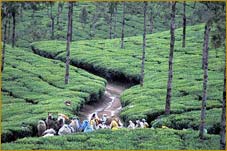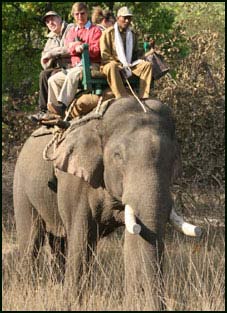National Parks

India is unique in the richness and diversity of its vegetation and wildlife. India's national parks and wild life sanctuaries (including bird sanctuaries) from Ladakh in Himalayas to Southern tip of Tamil Nadu, are outstanding and the country continues to “WOW” the tourists with its rich bio-diversity and heritage. Wildlife sanctuaries in India attracts people from all over the world as the rarest of rare species are found here. With 96 national parks and over 500 wildlife sanctuaries, the range and diversity of India's wildlife heritage is matchless. Some of the important sanctuaries in India are The Jim Corbett Tiger Reserve – Uttaranchal, Kanha National Park and Bandhavgarh National Park in Madhya Pradesh, Ranthambhor National Park - Sawai Madhopur etc.

We have suggested here some of the most popular itineraries taken by our clients and we have also incorporated their valuable
suggestions. However you can always customise this itineraries as per your requirement.
We have not placed the prices here as it is season dependent.

Itineraries
Bandhavgarh has an undulating landscape with around 32 hills some with flat
plateaus and overhanging cliffs. Some perennial streams and rivulets crisscross
this park creating fertile vegetation on the riverbanks. The area’s combination
of hills, rivers and valleys, meadows and marshes has created a unique biodiversity
evident in the varied luxuriant vegetation.
It is one of the finest birding areas in the world, Bharatpur Bird Sanctuary
(Keoladeo Ghana National Park) is a reserve that offers protection to
zoological species as well. It is the habitat of water- birds as well
as migratory water birds and waterside birds, this sanctuary is also inhabited
by Sambhar, Chital, Nilgai and Boar.
Nestling in the foothills of the Himalayas, the Corbett National Park extends
over an area of 1318 sq. kms. Varied topography and vegetation gives Corbett
a rich diversity in habitats and natural beauty. It was the first national Park
to be established in India in the year 1936 and it was here that the prestigious
“Project Tiger” was launched in 1973.
Situated in the foot hills of Himalayas in the terai region, the Dudhwa National
Park, which is also a Tiger Reserve, is a relatively new entrant in Project
Tiger.
Dudhwa’s terai vegetation comprises of savannah grasslands interspersed
with forests consisting of trees such as Jamun, Shisam, Silk Cotton tree, Khair
etc.
Situated in the Indian state of Madhya Pradesh, the picturesque Kanha National
Park was the inspiration behind Rudyard Kipling's unforgettable classic Jungle
Book .Over 1,940 sq km of bamboo thickets, extensive grasslands and dense sal
forests make up Kanha- a series of plateaus which stretch across the eastern
segment of the Satpura ranges in Madhya Pradesh.
Kaziranga National Park in Assam India, is best-known as the home of the Indian
Rhinoceros, declared a World Heritage Site, by UNESCO in 1985, Kaziranga National
Park lies in the flood plains of the Brahmaputra River, and is flat country
with elephant grass and shallow swamps interspersed with large patches of semi-evergreen
forest. It is bounded by the Mikir Hills on the South and the Mighty Brahmaputra
river on the north.
The park, set against the backdrop of the historic 1000-year-old Ranthambore
Fort, lies in the area where the ancient ranges of the Vindhyas' flat-topped
hills merge with the sharp ridges of the Aravalis. The park's uniqueness lies
in its man-made lakes and ancient reservoirs, which have merged into the natural
system as vital sources of water.
National Parks Booking Form
 India is unique in the richness and diversity of its vegetation and wildlife. India's national parks and wild life sanctuaries (including bird sanctuaries) from Ladakh in Himalayas to Southern tip of Tamil Nadu, are outstanding and the country continues to “WOW” the tourists with its rich bio-diversity and heritage. Wildlife sanctuaries in India attracts people from all over the world as the rarest of rare species are found here. With 96 national parks and over 500 wildlife sanctuaries, the range and diversity of India's wildlife heritage is matchless. Some of the important sanctuaries in India are The Jim Corbett Tiger Reserve – Uttaranchal, Kanha National Park and Bandhavgarh National Park in Madhya Pradesh, Ranthambhor National Park - Sawai Madhopur etc.
India is unique in the richness and diversity of its vegetation and wildlife. India's national parks and wild life sanctuaries (including bird sanctuaries) from Ladakh in Himalayas to Southern tip of Tamil Nadu, are outstanding and the country continues to “WOW” the tourists with its rich bio-diversity and heritage. Wildlife sanctuaries in India attracts people from all over the world as the rarest of rare species are found here. With 96 national parks and over 500 wildlife sanctuaries, the range and diversity of India's wildlife heritage is matchless. Some of the important sanctuaries in India are The Jim Corbett Tiger Reserve – Uttaranchal, Kanha National Park and Bandhavgarh National Park in Madhya Pradesh, Ranthambhor National Park - Sawai Madhopur etc. 




































